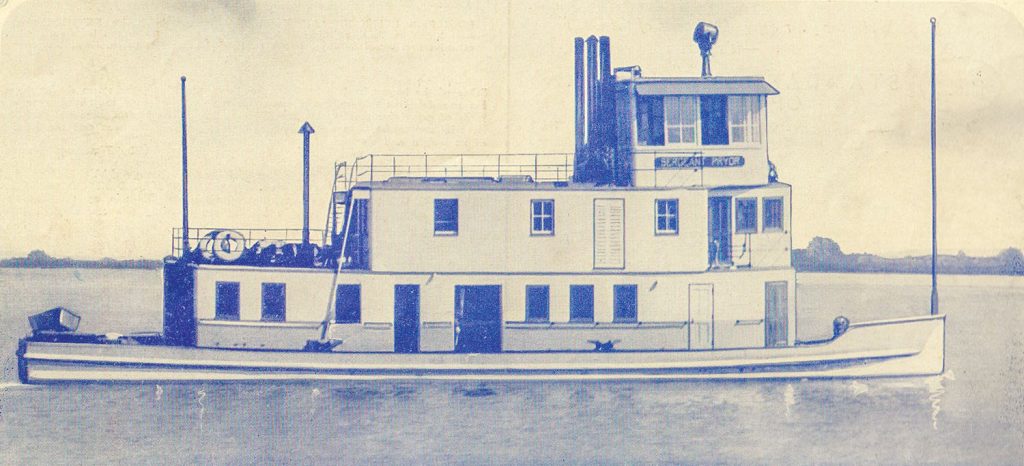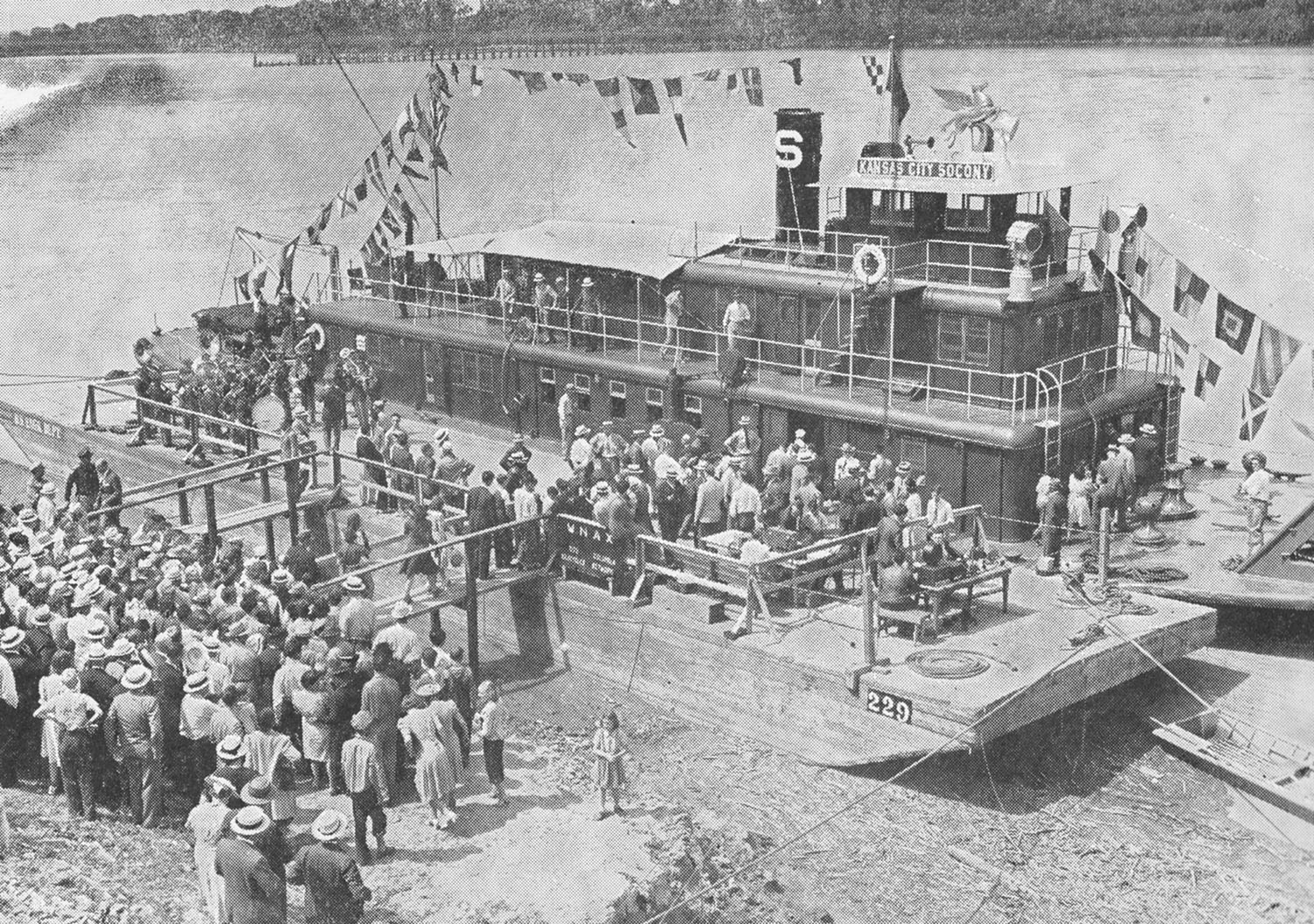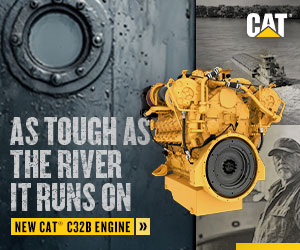In the September 18, 2023, issue of The Waterways Journal, this column detailed the Kansas City Socony and mentioned that it had initiated the first oil tow into both Omaha, Neb., and Sioux City, Iowa. The July 6, 1940, issue of the WJ carried an extensive piece about the arrival of that first tow into Sioux City. The story was headlined “Ol’ Man Missouri River Comes Back to Life at Sioux City.” The headline above the actual story indicated that this trip was not only the first oil tow, but that Socony-Vacuum, the owners of the Kansas City Socony, were, in fact, opening navigation to the area.
A large photo depicted the boat laying alongside a flat at the U.S. Engineers’ material yard, with many people looking on. The caption stated that “hundreds of spectators” lined the bank as the boat arrived on the morning of June 27, 1940. The caption also said that this arrival marked the “actual opening of the newly improved Missouri River to commercial traffic at Sioux City.” The tow had consisted of two barges loaded with 400,000 gallons of gasoline.
The Kansas City Socony had been escorted into Sioux City by the U.S. Engineer inspection boat Sergeant Pryor and the Coast Guard buoy boat Goldenrod. A group of “prominent citizens” had been aboard the escort boats and transferred to the Socony boat a few miles below town. Ceremonies celebrating the event were carried out at the Engineer dock, with George R. Call, president of the Sioux City-New Orleans Barge Line and chairman of the waterways committee that had championed the Missouri River improvements, the first to make remarks. He then introduced other speakers.
David F. Loepp, mayor of Sioux City, was featured, as were members of the local chamber of commerce; officials of the Socony-Vacuum Oil Company; Lachlan Macleay, president of the Mississippi Valley Association; and even the Chicago & Northwestern Railroad, “whose lines will be used by the Socony-Vacuum Oil Company for shipment of its products out of Sioux City.” The Kansas City Socony was open for “public inspection” following the ceremonies, and then it moved the tow downstream to the Socony docks, where it took some 12 hours to discharge the cargo of gasoline.
The crew of the Kansas City Socony on this historic trip included Capt. Francis Walters, master; Capts. Leonard Thompson and J.V. Rector, pilots; Capt. Roy Holland, a regular pilot for the U.S. Engineers on the Sergeant Pryor aboard as adviser; L.J. Treymane and Arthur Chester, engineers; Gay Pilgrim, mate; Adrian Herzog, watchman; John Carey, dayman; Michael Waldner, pumpman; E. Freyhage and E. Rhodes, tankermen; Emil Antrainer and Donald McNamara, deckhands; O.J. Russell, steward; and Bob Kordisch, mess boy. The Capt. Leonard Thompson mentioned was long with the Inland Waterways Corporation (Federal) and must have been loaned out to Socony for this event. He would later be on the Steamer Minnesota when it struck the Sibley bridge and sank in 1951 (WJ June 20, 2022) and would go on to serve as master of the big America and United States before he retired.
The crew of the Coast Guard’s Goldenrod had included John D. Jenkins, master; William A. DuPree, machinist; Harry E. Nielson, machinist mate; Nolan S. Driggers, “ship’s cook, second class”; Stuart C. Wheeler, seaman, first class; Jules J. Escoffier, seaman, second class; Daly S. Hyde, chief quartermaster; George P. Frazier, head deckhand; and Herbert H. Kremer and Fred A. McNaughton, deckhands.
The Sergeant Pryor had a crew consisting of Capt. Ed Heckman, master; W.G. Ray, chief engineer; Albert J. Uffelman, striker; Ray Patterson, R.W. Wickersham and Fred Stapenhorst, deckhands; M.L. Mallot, cook; W.L. Wilson, cabin boy; and John D. Donehue, shipkeeper. Capt. Roy Holland, usually aboard as pilot, was aboard the Kansas City Socony, as mentioned previously.

The Sergeant Pryor, named in honor of a member of the Lewis & Clark Expedition, had been built at Dubuque, Iowa, by Dubuque Boat & Boiler Company in 1935. It had a steel hull measuring 81 by 25 feet. As originally built, it had a sharp model bow, with no towknees, and was described as an inspection boat. The twin props were driven by a pair of Fairbanks-Morse five-cylinder Model 35-E-8-3/4 direct-reversing diesels. These engines produced 125 hp. each at 400 rpm. A 12-1/2 kW DC generator driven by a Fairbanks model 36-A-4-1/4 20 hp. diesel was in place for electrical power. It was also equipped with two 5 kW generators that were driven from the forward end of the two main engines.
The Sergeant Pryor departed Dubuque on August 25, 1935, for Omaha, Neb., where she was then in service to the U.S. Engineers performing inspection and survey work throughout the Missouri River. Though small in size, original descriptions indicate that the second deck cabin was set up to accommodate “16 officers in four staterooms.” The lower cabin was to house the galley, engineroom and “space for four officers in two staterooms besides the crew’s quarters forward.” With a full crew complement it must have been crowded.
In 1952, the boat was sold to Ray Logsdon, Beardstown, Ill., who renamed it John C in 1953. It was sold in March 1957 to Capt. J.W. Menke, St. Louis, who renamed it Chaperon. In 1959 it was again sold to Calvert City Towing Company, Calvert City, Ky., who only owned it for a short time before selling it to Brokamp & Bressler Inc., Cincinnati. In 1960 it was repowered with another pair of F-M direct-drive diesels, then boasting 360 hp. In 1964 it was sold to Bartley Towing Company, Portsmouth, Ohio, which renamed it Capt. Tom in 1965. It was last listed in the 1967 Inland River Record with the notation “has been under title lately of Rita Bartley & Sons.”
When I was a deckhand in the mid-1970s, the boat I was working on was standing by for barges at what was then Black River Mining on the left descending bank of the Ohio River about Mile 441, near Carntown, Ky. Having noticed a boat hull lying partially sunk inside the facility mooring cells, I walked up the fleet to investigate. The cabin was completely gone, leaving only the steel hull, but welded letters on the stern transom were easy to make out, “SERGEANT PRYOR.”
I have been unable to find out exactly what happened to the boat, but Capt. Bill Judd, retired marine surveyor in the Cincinnati area, says that at one time a company called River Marine Corporation, operated by brothers named Sullivan, performed the shifting services there, and he recalled them building a small towboat either alongside or on the Pryor hull. About 1974, River Marine Corporation relocated to Stillwater, Minn.
Capt. David Smith can be contacted at davidsmith1955obc@gmail.com.




